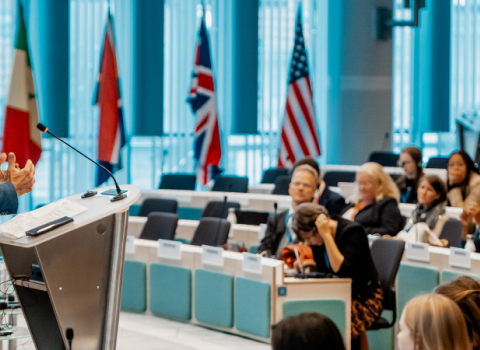The EU biotech and biomanufacturing initiative due to be published later this month is an opportunity to take urgent and immediate action to support the scale up of the sector

Nicoló Giacomuzzi-Moore, executive director of the Circular Bio-based Europe Joint Undertaking
European bio-based sector has come a long way since the EU adopted its first bioeconomy strategy in 2012 and with the Commission due to present its biotech and biomanufacturing initiative later this month, action is needed to build on these foundations and strengthen the competitiveness of EU industry, says Nicoló Giacomuzzi-Moore, executive director of the Circular Bio-based Europe Joint Undertaking (CBE JU).
Giacomuzzi-Moore is calling for an industrial strategy to help speed up translation and scale-up of Europe’s leading research - and guide innovative solutions “from the niche to the norm.”
Without this, there is a risk that technologies developed in Europe with framework programme funding will “end up going in search of markets and deployment at industrial scales in other countries,” Giacomuzzi-Moore said.
CBE JU’s predecessor, the Bio-based Industries JU, was a key pillar of the 2012 strategy. Since then, the public-private partnership has funded 16 first-of-their-kind biorefineries and more than 80 demonstration plants, using renewable biological resources to produce food and feedstock ingredients, biofuels and bioplastics.
But other parts of the world have also stepped up investments, including the US, China and India. In September 2022, US president Joe Biden signed an executive order to launch a National Biotechnology and Biomanufacturing Initiative, which includes a $1.2 billion investment in manufacturing infrastructure from the Department of Defense.
Across the Atlantic, funding moves quickly with few administrative hurdles, said Giacomuzzi-Moore, who recently took up the executive director role after previously occupying it on an interim basis.
“It takes us, from the opening of the call to the signature of the grant and the start of the project, a bit more than a year. In the US, it goes much faster,” he told Science|Business.
“Together with the European Commission, we are reflecting on ways to make our beneficiaries’ lives a bit easier in terms of reporting, and shortening the time from the opening of the call to the signature of the grant,” said Giacomuzzi-Moore.
The issue is not a lack of research and innovation in Europe. “Now there are some hurdles that come from a lot of regulation that has been produced over the last five years, in the context of the Green Deal, but not only,” Giacomuzzi-Moore said.
The shortcomings of the regulatory framework was one of the issues highlighted in December when the industry came together for the CBE JU’s stakeholder forum, as was increased global competition.
A lack of coherent definitions and standards penalises bio-based products compared to cheaper, fossil-based alternatives, a report published after the forum said.
In addition, “taxonomy regulation should be updated to open the door for more products that are bio-based,” said Giacomuzzi-Moore. The EU’s definition of sustainable investments includes only certain aspects of the bioeconomy, and this has a notable effect on the ability to secure funding from the European Investment Bank (EIB).
Despite these challenges, SME participation in the joint undertaking is strong. In the early days of the Bio-Based Industries JU, SMEs participated mostly in the demonstration phase but they are now increasingly involved in early-stage research as well as biorefinery projects.
Regional component
Looking to the future of the joint undertaking, and its potential extension beyond the end of Horizon Europe in 2027, Giacomuzzi-Moore sees the partnership becoming “even more focused on the implementation of the bioeconomy”.
This will require efforts to reduce red tape and speed up the permitting process for innovative products. Regulatory sandboxes, which allow new technologies that are not fully compliant with the existing regulatory framework to be tested, could be one way forward.
Synergies with other funding instruments will also be crucial in the years to come. The CBE JU funds first-of-a-kind biorefineries to demonstrate their viability, but there is a funding gap when it comes to replication which risks pushing new technologies outside of Europe, Giacomuzzi-Moore says.
“We should explore possibilities to give them privileged access to other types of European funding,” he said. This could come from the European Innovation Council, the EIB, or from national funds such as the pandemic recovery fund and structural funds.
Member states should have a stronger role in the next iteration of the joint undertaking, to foster complementarity between EU and national funding.
Biorefineries are usually characterised by short supply chains, providing opportunities for local farmers and for regional development more generally.
Farmer buy-in
In recent months there has been some pushback against the Green Deal, including from farmers and from within Commission president Ursula von der Leyen’s EPP party. But Giacomuzzi-Moore expects the biotech and biomanufacturing initiative to remain on the agenda regardless of the outcome of June’s European elections.
He points out that right-wing governments in Hungary and Italy have been supportive of the bioeconomy. “The beauty and the difficulty of the bioeconomy is that it covers so many sectors, and so you wouldn’t exclude anybody,” he said.
In April 2023, EU farming ministers called on the Commission to better integrate the bioeconomy into all policies, highlighting its potential for job creation, rural regeneration, and reducing fossil-fuel dependency.
As farmers protest outside EU institutions in Brussels, Giacomuzzi-Moore says it is important to include the sector in discussions about the bioeconomy.
Not only does it provide an opportunity to diversify incomes by selling crop residues which would otherwise go to waste, but CBE JU is also working on projects to develop bio-based pesticides and fertilisers.
The day after the interview with Science|Business, the JU was due to meet with 60 farmers’ and primary producers’ associations to discuss opportunities and challenges, as part of its deployment groups.
Consumers also need to be convinced, but Giacomuzzi-Moore believes work on replacing oil-based textiles has potential to make a difference. “We wear textiles every day, so this could really help in bringing the value of bio-based technologies to citizens,” he said.
Another recent trend has been towards new types of biomass, such as aquatic feedstock from algae, rather than the more common agricultural and forest biomass. Municipal waste is another source the CBE JU wants to focus on as it has potential to increase circularity.
In the final years of Horizon Europe, Giacomuzzi-Moore is calling on industry to come with bold ideas. “It would be great if in 2026 and 2027, we have some really bold research topics funded, something that is high risk and high reward, and goes beyond business as usual.”
It is not yet certain whether CBE JU’s mandate will be extended in the next framework programme, but he believes its work is not yet done.
“We should not see the joint undertaking as an eternal instrument, but an instrument that took a sector that was extremely fragmented, helped build a community that is still working on derisking and getting people together, before moving to a third stage where CBE will support the full deployment of the bioeconomy,” he said.





 A unique international forum for public research organisations and companies to connect their external engagement with strategic interests around their R&D system.
A unique international forum for public research organisations and companies to connect their external engagement with strategic interests around their R&D system.